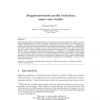Free Online Productivity Tools
i2Speak
i2Symbol
i2OCR
iTex2Img
iWeb2Print
iWeb2Shot
i2Type
iPdf2Split
iPdf2Merge
i2Bopomofo
i2Arabic
i2Style
i2Image
i2PDF
iLatex2Rtf
Sci2ools
ENTCS
2010
2010
Fragments-based Model Reduction: Some Case Studies
Molecular biological models usually suffer from a dramatic combinatorial blow up. Indeed, proteins form complexes and can modify each others, which leads to the formation of a huge number of distinct chemical species (ie non-isomorphic connected components of proteins). Combinatorial complexity forbids an explicit description of the quantitative semantics (stochastic or differential), since the set of states is usually a vector space the dimension of which is the number of distinct chemical species. Model reduction aims at reducing this complexity by providing another grain of observation. Fragments-based reduction consists in computing a set (hopefully smaller than the set of chemical species) of pieces of chemical species, such that the evolution of the number entration) of these pieces can be soundly described in self-consistent abstract quantitative semantics. In this paper, we provide several intuitive examples so as to give some intuition about approach may work; and why stochas...
Related Content
| Added | 02 Mar 2011 |
| Updated | 02 Mar 2011 |
| Type | Journal |
| Year | 2010 |
| Where | ENTCS |
| Authors | Jérôme Feret |
Comments (0)

